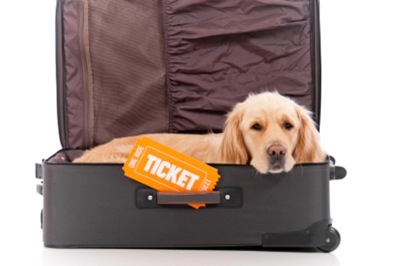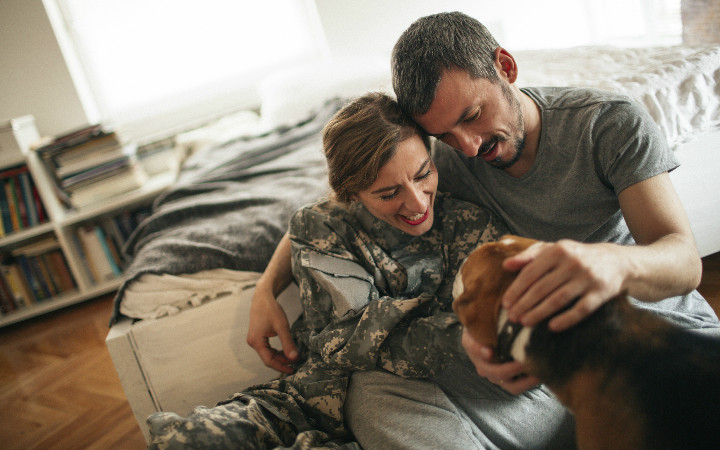Prepping your pet for PCS
When a United States Armed Forces service member receives a Permanent Change of Station order, there also comes an unwritten list of “things to do prior to moving.” There is outprocessing, organizing the move, preparing the family, saying your good-byes … the list goes on and on. And, of course, don’t forget your pets!
These days, the regulations involved in moving or traveling with the family pet overseas are becoming more complex. Relocating can be incredibly stressful for both you and your pet, but don’t worry: this article and its sequel will help you understand the necessary steps. 
There are a few things that every pet will need in order to relocate, and a few that some, but not all, will need. This first of two articles will focus on the former, and the second will address the latter.
What every pet needs:
- An ISO-compliant microchip
- Proof of rabies vaccination, with the microchip number on the certificate
- Health certificate (varies by country) and acclimation letter for flying
The microchip
First and foremost, cats and dogs MUST have an ISO (International Standards Organization)-compatible microchip, meaning it can be read by most international microchip scanners. Some countries will allow you to have a non-ISO compatible microchip, but they require that you bring a scanner with you in order to read it. If your pet already has a non-ISO compatible microchip, it is okay for him to receive a second chip. Just keep the paperwork for both chips in your records, and let the person scanning your pet know that there are two chips.
I cannot stress this next point enough: get the ISO-compatible microchip as soon as you reasonably can. If you have a puppy or kitten, make sure your veterinarian implants the microchip along with the rabies vaccination (or before). If your pet is older, make sure you get a microchip as soon as possible.
Rabies certificate
Why is it so important to get the microchip sooner rather than later? Many countries require the microchip number to be listed on your pet’s rabies certificate. This can only be done if the veterinarian implants the microchip at the same time as he or she administers the rabies vaccine, or uses a scanner to read the already-implanted microchip. This means your pet may need to be re-vaccinated for rabies – even if he is up to date – in order to have the microchip number listed on the rabies certificate. It will not hurt your pet to receive another vaccine if needed.
Don’t assume that your veterinarian’s office will enter the microchip number on the certificate. Double check that it is there, and that the number is correct!
In addition, be sure to check regulations in your destination country, since some countries – such as Japan – require that any pet older than 91 days receive at least two rabies vaccines at least 30 days apart. In other words, if your pet is overdue, they will need to receive two vaccines to meet these requirements. And yes, the microchip number must still be on the most recent rabies certificate.
Health certificate & acclimation letter
So you have the ISO-compatible microchip and the rabies certificate containing the microchip number. What else do you need?
Prior to departure, you need to get a certificate from your veterinarian stating that your pet is in good health and is okay to travel; these are country specific. While the health certificate is generally valid for thirty days, the airlines require that the health certificate be issued within 10 days of travel.
Health certificates have to be endorsed by your state’s U.S. Department of Agriculture, Animal and Plant Health and Inspection Service office. Some countries will allow military veterinarians to endorse the certificate, but many require that the endorsement come from the state office. Make arrangements in advance to either bring the health certificate to your USDA office, if it is within reasonable driving distance, or your veterinarian may have to send it for endorsement. Find out as early as possible if the health certificate will need to be sent out so that you can allow for this turn-around. There is generally a service fee for this endorsement.
If you’re flying in an airplane, you will need an acclimation letter for your pet as well. If your pet is too large to ride in the cabin with you he will need to ride in the cargo hold, which is not temperature-regulated. The letter specifies the ambient temperatures that are safe for your pet to travel.
For many PCS-ing pets, those will be the only requirements. But for others, the list is a bit longer. In The PCS-ing cat and dog: part 2, we’ll take a look at what additional requirements some pets may need.
About the author
Dr. Rebecca Jackson is a staff veterinarian for Petplan pet insurance, a proud sponsor of Pets for Patriots. As the daughter of a veterinarian, Dr. Jackson grew up in a small animal vet practice in northern Indiana, and has seen the good, the bad and the ugly of veterinary medicine – and she loves it unconditionally.
Dr. Jackson received her Bachelors of Science degree from Purdue University in 2002, and then attended the Washington State University College of Veterinary Medicine. Upon graduating from WSU in 2006, Dr. Jackson moved to Boston to begin her adventures as a small animal veterinarian. She has practiced in Tacoma, Washington , and Richmond, Virginia, where she served as a civilian veterinarian at the Fort Lee Veterinary Treatment Facility. Currently, in addition to her work at Petplan, Dr. Jackson works as a relief veterinarian for a handful of hospitals in the Philadelphia area. Dr. Jackson and her husband reside in Philadelphia with their daughter, their 9- year-old Golden Retriever and their 8-year-old cat.












i have a sweet cat and lovely god they are always with me . Sometimes they play i enjoy this moment .
Please allow me to make a very serious correction to your above article. The cargo hold area
that is used for live animals IS MOST certainly temperature controlled. ALWAYS….
The so called letter or certificate of acclimation is ONLY used for colder temps, NOT, for higher
temps. Also. This has NOTHING to do with inside temps of the plane. ONLY has to do with
outside temps. The only airline that I know of that requires this is: American Airlines and for
cold outside temps. I’ve been doing this for over 43 years
Otherwise the article seems to be very good.
Sincerely, Jerry Mishler